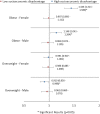Socioeconomic disadvantage and its implications for population health planning of obesity and overweight, using cross-sectional data from general practices from a regional catchment in Australia
- PMID: 27142857
- PMCID: PMC4861099
- DOI: 10.1136/bmjopen-2015-010405
Socioeconomic disadvantage and its implications for population health planning of obesity and overweight, using cross-sectional data from general practices from a regional catchment in Australia
Abstract
Objectives: To identify smaller geographic and region-specific evidence to inform population health planning for overweight and obesity.
Design: Cross-sectional secondary analysis of data.
Setting: Primary healthcare-17 general practices located in the Illawarra-Shoalhaven region of New South Wales (NSW).
Participants: A subset (n=36 674) of the Sentinel Practices Data Sourcing project adult persons data set (n=118 794) that included information on disease status of all adult patients who had height and weight measurements recorded in their electronic health records and had visited the included general practices within the Illawarra-Shoalhaven region of NSW between September 2011 and September 2013.
Main outcome measures: Age-adjusted odds ratio (aOR) of overweight and obesity was determined for high and low levels of socioeconomic disadvantage based on Socio-Economic Indexes for Areas (SEIFA)-Index of Relative Socio-Economic Disadvantage (IRSD) scores of patients' residential statistical local area.
Results: In men, overweight was lowest in areas of highest socioeconomic disadvantage (aOR=0.910; 95% CI 0.830 to 0.998; p<0.001); but no statistically significant association with socioeconomic score was found for women. Overall obesity was associated with high socioeconomic disadvantage (aOR=1.292; 95% CI 1.210 to 1.379; p<0.001).
Conclusions: This type of data analysis reveals multiple layers of evidence that should be assessed for population health approaches to curb the epidemic of obesity and overweight. It strongly highlights the need for preventive health initiatives to be specific to gender and socioeconomic attributes of the target population.
Keywords: EPIDEMIOLOGY; PRIMARY CARE; PUBLIC HEALTH.
Published by the BMJ Publishing Group Limited. For permission to use (where not already granted under a licence) please go to http://www.bmj.com/company/products-services/rights-and-licensing/
Figures
References
-
- OECD. Health at a glance 2013. OECD Publishing, 2013.
-
- Australian Government Department of Health. Healthy communities initiative. Secondary Healthy communities initiative 2010. http://www.healthyactive.gov.au/internet/healthyactive/publishing.nsf/Co...
-
- O'Hara BJ, Phongsavan P, McGill B, Maxwell M, Ahmed N, Raheb S, Bauman AE. The NSW Get Healthy Information and Coaching Service: the first five years. NSW Ministry of Health and Prevention Research Collaboration. Sydney: University of Sydney, 2014: 1-36. http://www.gethealthynsw.com.au/assets/pdf/medicalprofessionals/resource....
-
- Australian Bureau of Statistics. Australian Health Survey: Updated Results, 2011-2012. Secondary Australian Health Survey: Updated Results, 2011-2012 2013. http://www.abs.gov.au/ausstats/abs@.nsf/Latestproducts/33C64022ABB5ECD5C...
MeSH terms
LinkOut - more resources
Full Text Sources
Other Literature Sources
Medical

